
Almelo is a municipality and a city in the eastern Netherlands. The main population centres in the town are Aadorp, Almelo, Mariaparochie, and Bornerbroek.
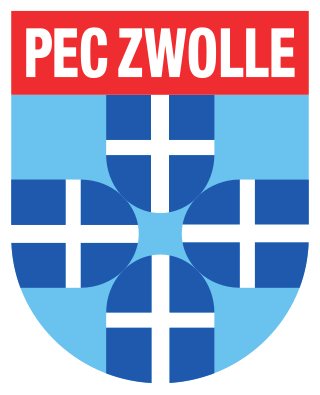
PEC Zwolle is a Dutch professional football club based in Zwolle, Netherlands. They play in the Eredivisie, the top tier of Dutch football. They have played in the Eredivisie for a total of 22 seasons, reaching sixth place in 2015. They won the KNVB Cup in 2014 and also reached the final in 1928, 1977 and 2015.
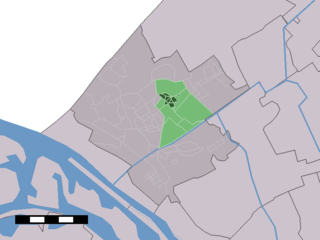
Honselersdijk is a town in the Dutch province of South Holland. It is home to the historic Huis Honselaarsdijk, former palatial estate of the Dutch Princes of Orange. Huis Honselaarsdijk was one of the finest examples of Baroque architecture and grounds in the history of The Netherlands. Today, only part of the outbuildings remain, and these are referred to locally as "De Nederhof".

Nieuwleusen is a town in the Dutch province of Overijssel with 9300 inhabitants as of 2021. In the 2001 municipal reform, most of the former municipality of Nieuwleusen was incorporated into the municipality of Dalfsen. Some parts of the former municipality, including the Lichtmis area, was added to the neighbouring municipality of Zwolle.

The Van Wassenaer family is the name of an old Dutch noble family. It was first mentioned in the County of Holland on 3 November 1200. They are one of the few original noble families from Holland that has survived to this day. Members of the family carry the title of count or baron.
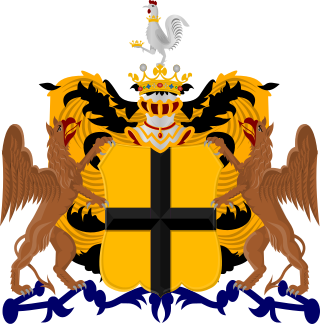
The House of Bylandt is the name of an ancient house of nobility originating in the Lower Rhine region. It later split into the cadet branches of Bylandt-Well, Bylandt-Rheydt and Bylandt-Halt-Spaldorf.

The House of Helfenstein was a German noble family during the High and Late Middle Ages. The family was named after the family castle, Castle Helfenstein, located above Geislingen an der Steige in the Swabian Alb region of Baden-Württemberg, Germany. The family held the rank of Graf or Count and was very significant in the 13th and 14th Centuries, but fell into financial difficulties and the family lost its estate in 1627.

William was Duke of Guelders, as William I, from 1377 and Duke of Jülich, as William III, from 1393. William was known for his military activities, participating in the Prussian crusade five times and battling with neighbors in France and Brabant throughout his rule. His allies included Holy Roman Emperors, Charles IV and Wenceslaus, Richard II of England, and Conrad Zöllner von Rothenstein, the Grand Master of the Teutonic Knights. During his reign the duchies of Guelders and Jülich were temporarily unified.
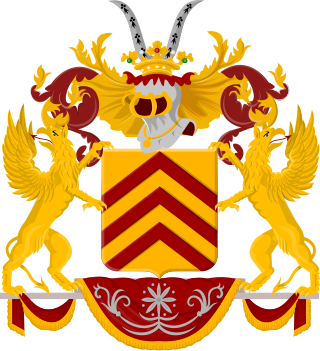
The van Voorst tot Voorst family is an old Dutch noble family from the province of Overijssel.
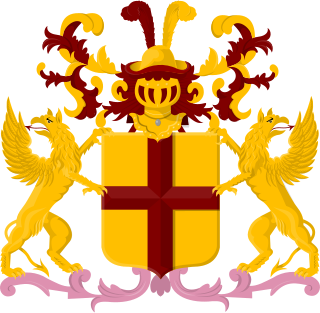
Van Heeckeren is an old Dutch noble family from the Dutch provinces Overijssel and Gelderland.

Bicker is a very old Dutch patrician family. The family has played an important role during the Dutch Golden Age. They led the Dutch States Party and were at the centre of Amsterdam oligarchy from the beginning of the 17th century until the early 1650s, influencing the government of Holland and the Republic of the United Netherlands. Their wealth was based on commercial transactions, and in their political commitment they mostly opposed the House of Orange.
Rudolf or Rodolphe, was a Lower Lotharingian noble born into a family with connections to Utrecht. He is thought by some modern interpreters to have later had lordships in the Hesbaye region which is now in Belgium, in a part which mostly came to be incorporated into the later County of Loon. He was a son of Nevelung, Count of Betuwe, and a daughter of Reginar II, Count of Hainaut, whose name is not known. He had two uncles, one paternal and one maternal, who were both named Rudolf, and various proposal have been made about how the three Rudolfs correspond to various references to "Count Rudolf" in the 10th century "low countries". Although his paternal uncle Rudolf is sometimes considered to have become a cleric, Jongbloed (2006) argued that he must have been a count, and that he certainly had a wife and offspring. There is no contemporary record of young Rudolf, the nephew, as a count, nor indeed as an adult.
The County of Duras was a medieval county with its seat at the castle of Duras. The 18th century version of this castle still stands and is a part of modern Sint-Truiden in the province of Belgian Limburg. The county was one of several counties in the Hesbaye region which covers the south of Belgian Limburg, and stretches into the neighbouring provinces. As a distinct entity under the name Duras the county only existed within the 12th century. After the first male line of counts died out, the county of Duras came by marriage to the Counts of Montaigu, whose other holdings were further south. Later they became part of the neighbouring County of Loon, which was ruled by cousins of the original counts of Duras.

Beverweerd Castle is a 13th century castle and former knight's court town, which is located on an island along the Kromme Rijn near the village of Werkhoven in the Dutch province of Utrecht. The castle is surrounded by landscaped gardens, in which the Kromme Rijn itself plays an important role in the landscape. The castle was empty for a long time and was not open to the public. Since 2006, painter and art forger Geert Jan Jansen has lived and worked at Beverweerd Castle. The surrounding gardens are ideal for walking, which offers a good view of the castle and the Kromme Rijn.
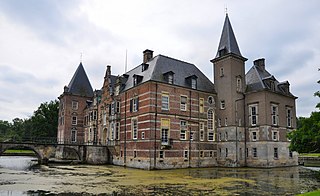
Twickel is a protected historic country estate with 81 complex parts near Delden in the hamlet of Deldeneresch, in the municipality of Hof van Twente in the province of Overijssel in The Netherlands. The moated castle forms the center.

The NS 3400 was a series of goods steam locomotives of the Dutch Railways (NS), ordered by its predecessor the Hollandsche IJzeren Spoorweg-Maatschappij (HSM).

Marie-Thérèse Marguerite Jeanne (Maïté) Duval was a French-born Dutch sculptress and drafter.
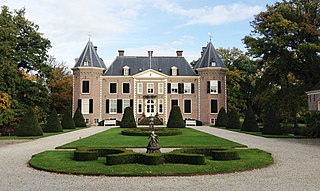
Nijenhuis is a castle and an estate near Diepenheim in the municipality Hof van Twente, Netherlands.
.






















